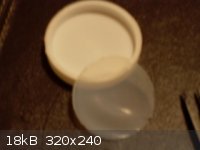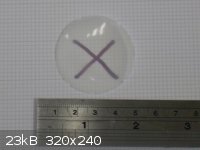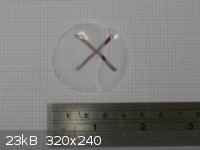Swede
Hazard to Others
  
Posts: 491
Registered: 4-9-2008
Member Is Offline
Mood: No Mood
|
|
The sol-gel process for electrodes; boehmite
I have several samples of differing SASOL-brand boehmites, which is a special form of aluminum oxide hydroxide. This is an interesting material with
a lot of potential, but I feel like a freshman approaching organic chemistry for the first time... the learning curve is steep, and I'm in deep water.
The material is interesting. It is a powder so fine that it handles like a liquid. When the clear container is swirled, it looks exactly like milk.
It actually continues to swirl after I set it down.
Literature is full of scholarly articles which reference boehmite as a material suitable for doping, catalytic reactions, etc, via the sol-gel process.
A good representative article: Comparison between Derived Sol-Gel and Conventional Methods for the Preparation of Dimensionally Stable Ta/IrO2 Anodes
for Oxygen Evolution found here.
Essentially, the porosity of the boehmite in a solution suspension allows it to be doped with a large variety of metallic complexes. These are then
applied to a substrate, and heated.
Electrophoretic deposition is a possibility. Perhaps PbO2 can be deposited into a conductive matrix, but PbO2 thermally decomposes at 400 C. Boron?
Maybe even magnetite?
Any thoughts on what I can do with this stuff? I've got a lot of it, in various grades. 
|
|
|
watson.fawkes
International Hazard
    
Posts: 2793
Registered: 16-8-2008
Member Is Offline
Mood: No Mood
|
|
I would look at deposition of boundary layers on titanium
substrates, with an eye to preventing passivation of the substrate when plating onto it. Think of it as a substitute for the commercial plater's
initial "strike" onto a surface that allows later deposition.
|
|
|
Swede
Hazard to Others
  
Posts: 491
Registered: 4-9-2008
Member Is Offline
Mood: No Mood
|
|
As I said, I'm in deep water.
It's a very interesting material. In a dilute suspension using plain water, it mimics milk. Zero settling. The particle sizes are so small, they
remain 100% suspended, yet undissolved. As the water evaporates, it gels. Looks like a white, translucent agar.
This stuff, depending upon formulation, sol attributes, and particle sizes, is also pH dependent, with excursions towards acid or base also causing
the gel state.
It can supposedly be fired. I have a bench furnace that can do 1,000 C. Anything it carries with it obviously will thermally decompose if the
chemical would do so normally. I've got a lot of study ahead of me.
|
|
|
daragh8008
Hazard to Self
 
Posts: 61
Registered: 15-10-2008
Location: Eire
Member Is Offline
Mood: Happy
|
|
As I mentioned in another tread I have also started to work with boehmite sols in the hope of making Al2O3 freestanding membranes. So this is one of
the things you can do with them. The attached image is of a free standing boehmite membrane made from aluminium isopropoxide. I not sure that you
could maake these with pre made sols but you could certainly try. Apparently the morphology is a critical parameter. This one was made by adding about
5g of aluminium isoporpoxide to 30ml H2O with vigorous stirring at 70C. The isopropanol formed was then distilled out. 0.5g of acetic acid was then
added to the hydroxide suspension and the whole lot transferred to a teflon hydrothermal reactor and heated at 160C for about 12 hours. The resultant
sol was slightly opaque with a blueish tinge. About 5ml of the sol was slowly evaporated in a teflon boat (well really a teflo beaker cut down to size
to ease removal of the membrane after drying) of the course of several day.Next week I calcinate it and hopefully it will still retain its shape. A
very interesting paper with the original method is: Naofumi Nagai and Fujio Mizukami
J. Mater. Chem., 2011,21, 14884-14889

|
|
|
Swede
Hazard to Others
  
Posts: 491
Registered: 4-9-2008
Member Is Offline
Mood: No Mood
|
|
That is really cool. Please report back on the calcination. May I ask, what is the ultimate goal of this project?
There must be a demand for the pre-made powdered boehmite, as SASOL makes and sells these by the ton in a wide array of particle sizes.
[Edited on 28-7-2012 by Swede]
|
|
|
daragh8008
Hazard to Self
 
Posts: 61
Registered: 15-10-2008
Location: Eire
Member Is Offline
Mood: Happy
|
|
I not really sure what the sasol powders are used for but if I were allowed to guess I would imagine that the are used in ceramic compositions and the
like. Also I know boehmite is being developed for anti reflection coating, and sintering aids for alumina. The membrane shown above was made using a
method developed used for making gas filters, although I don't think I have the right morphology yet for a gas filter ( ie the pore size is probably
too large) I am working on these membranes to examine the possibility of ultra thin ceramics. Apparently that can have very unusual properties such as
being flexible. Although, stiff far off on that because the membranes I has made are very brittle. Also I want to look at making thin ceramic spinels
by reacting freestanding al2o3 with oxide coatings such as ZnO. I'll let you know how the sintering goes. Hopefully it won't turn to powder again!
|
|
|
daragh8008
Hazard to Self
 
Posts: 61
Registered: 15-10-2008
Location: Eire
Member Is Offline
Mood: Happy
|
|
So the calcination seemed to go well. The images below show pre and post annealing at 750C for 1hr heating up at a rate of 10C per minute. There was a
slight increase in opacity but this is probably not noticeable in the images. The membrane had to be broken to get it into the tube furnace that I was
using and wasn't a result of the annealing. After the membrane seemed more robust and didn't require as much care in handling.
 
|
|
|
Swede
Hazard to Others
  
Posts: 491
Registered: 4-9-2008
Member Is Offline
Mood: No Mood
|
|
Thank you for sharing that! I would assume the heat up and down rates would need to be carefully controlled so as to not heat it asymmetrically, or
create stresses in the membrane.
There's a lot of room for experimentation. I hope these guys perform as you expect. Good luck!
|
|
|
hyfalcon
International Hazard
    
Posts: 1003
Registered: 29-3-2012
Member Is Offline
Mood: No Mood
|
|
I wonder if a pore size of .5 micron could be achieved in using it for thin wall ceramic filters. At that pore size, you would have something that
would purify water that you normally wouldn't look twice at for drinking purposes. What is the difference in this material chemically and regular
bentonite clay?
|
|
|
daragh8008
Hazard to Self
 
Posts: 61
Registered: 15-10-2008
Location: Eire
Member Is Offline
Mood: Happy
|
|
I believe that filters is one of the main uses for this type of membrane and in particular gas filtration. I'm not sure they would be physically
robust enough for liquids given the pressure that would be necessary to get anything through them. But I do recall people making the membranes on
larger pored alumina supporting substrates. Don't recall what they were filtering though. There are some papers on controlling the pore size etc. for
different filtration applications. I don't know much about bentonite other than a quick look at Wiki but these are pure(?) Al2O3 whilst bentonite
seems to be a alumina silicate of mixed composition.
|
|
|
hyfalcon
International Hazard
    
Posts: 1003
Registered: 29-3-2012
Member Is Offline
Mood: No Mood
|
|
Another name for bentonite is diatomacous earth. Bunch of little dead fossils clay.
|
|
|
edgecase
Hazard to Self
 
Posts: 65
Registered: 4-11-2011
Location: Ontario, Canada
Member Is Offline
Mood: Viscous
|
|
Bentonite is a type of clay, not diatomaceous earth.
|
|
|
hyfalcon
International Hazard
    
Posts: 1003
Registered: 29-3-2012
Member Is Offline
Mood: No Mood
|
|
Not what the geologist at the clay pit told me.
|
|
|
mnick12
Hazard to Others
  
Posts: 404
Registered: 30-12-2009
Location: In the lab w/ Dr. Evil
Member Is Offline
Mood: devious
|
|
edgecase is correct bentonite clays are a variety of ionic aluminosilicate minerals. Whereas Diatomaceous earth is almost exclusively amorphous silica
formed from the corpses of dead algae (Diatoms).
|
|
|
hyfalcon
International Hazard
    
Posts: 1003
Registered: 29-3-2012
Member Is Offline
Mood: No Mood
|
|
I stand corrected.
Diatomaceous earth is also known as diatomite, kieselguhr, or celite. It is a naturally occurring, chalk-like sedimentary rock that is easily crumbled
into a fine off-white powder. This powder is very light, due to its high porosity. The typical chemical composition of diatomaceous earth is 86%
silica, 5% sodium, 3% magnesium and 2% iron.
Bentonite is a naturally occurring material consisting predominantly of the clay mineral montmorillonite. Montmorillonite is a material species in the
family of sheet silicates called smectites. Other smecitite group minerals include hectorite, stevensite and saponite.
Indeed, the definition of bentonite can be expanded to include these other smectites, but deposits in which they predominate are more commonly
referred to by other names (hectorite, urasite, etc...)
Smectites are three-layer clay minerals. They consist of two tetrahedral layers of interconnected SiO4-tetrahedrons which enclose a central M(O,OH)6
-octahedron layer (M=Al, Fe, Mg and others). The silicate layers have a slightly negative charge that is compensated by exchangeable ions in the
intermediate layers. The charge is so weak that the cations (in natural form, predominantly Ca2+-, Mg2+- or Na+-ions) can be adsorbed with an
associated hydrate shell (innercrystalline swelling).
An essential characteristic of all smectite minerals is their ability to absorb tremendous amounts of water and other liquids into their sheet
structures. This gives bentonite extraordinary swelling and adhesive properties that are exploited commercially by many industries. The ability of
smectite to absorb water is due in part to by the inherently small grain size of individual smectite crystals (typically much less that 2µ) and to
the fact that individual sheets possess a negative surface charge which tends to attract polar molecules (Figure). This negative charge is also
responsible for another essential attribute of smectite - its ability to absorb positively charged ions from solutions, an attribute which, like
adhesion, is also exploited commercially.�
Montmorillonites and related smectite minerals are capable of forming in many types of geologic environments and through a variety of mechanisms.
However, an essential ingredient in their formation is water. During the reaction of water with rock, the surfaces of unstable minerals dissolve and
contribute ions to the surrounding solution. As these solutions become saturated, new minerals precipitate that are more stable under the prevailing
geological conditions. If the chemistry of the rock being dissolved is suitable, these new minerals will include smectites. In actuality, smectites
are common constituents of most earth surface sediments and can form through the reaction of a wide variety of rock types so long as these rocks are
rich in silicon and other essential elements. However, the formation of large deposits of smectite (i.e., bentonite) require rather special geological
conditions.
Because smectites are water-born minerals, volcanic environments provide among the most favorable conditions for the formation of large deposits of
smectite. This is because the hot circulating waters often associated with such environments tend to increase the intensity and rate of water-rock
reactions. The geological probability of producing a large bentonite deposit is further increased if the reacting rock consists of volcanic glass
because volcanic glasses are chemically unstable under earth surface conditions and are often fractured, leading to highly reactive surfaces. Deposits
rich enough in smectite to be considered bentonite can also form during low temperature weathering of non-volcanic rocks, but these deposits tend to
be less extensive.
Finally, depending on the nature of their genesis, bentonites will contain a variety of accessory minerals in addition to montmorillonite. These may
include lesser amounts of other clay minerals such as attapulgite, kaolin, mica and illite as well as non-clay minerals like quartz, feldspar, calcite
and gypsum. The presence of these minerals will affect the industrial value of a mined deposit, reducing but sometimes increasing its value depending
on the application.
|
|
|